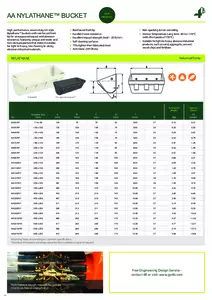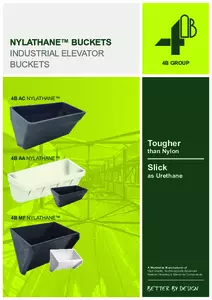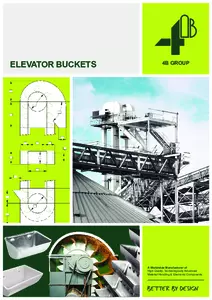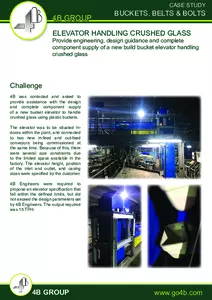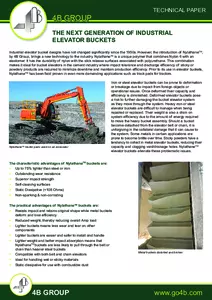4B AA Nylathane™ Elevator Bucket
Industrial Duty Elevator Bucket
AA43/NY, AA54/NY, AA64/NY, AA74/NY, AA75/NY, AA85/NY, AA95/NY, AA96/NY, AA106/NY, AA116/NY, AA126/NY, AA127/NY, AA147/NY, AA148/NY, AA168/NY, AA188/NY, AA208/NY, AA228/NY, AA248/NY, AA1810/NY, AA2010/NY, AA2210/NY, AA2410/NY
High performance, severe duty AA style Nylathane™ bucket with reinforced front lip for unsurpassed impact and abrasion resistance, featuring unique anti-static and non-stick properties that make it suitable for light to heavy, free-flowing to sticky, abrasive industrial materials.

Product Features
- Reinforced front lip
- Excellent wear resistance
- Excellent impact strength (Izod – 20 KJ/m2)
- Self-cleaning surfaces
- 75% lighter than fabricated steel
- Anti-Static (108 Ohms)
- Non-sparking & non-corroding
- Service Temperature: Long term -40 to +110°C (with short peaks of 150°C)
- Suitable for light to heavy abrasive industrial products, such as sand, aggregate, cement, wood chips and fertilizer.
Material
Nylathane™
Use by Industry
Industrial
Use by Product
Sticky Materials,
Light Industrial,
Heavy Industrial
Specifications

| AA Nylathane | Nominal size | A | B | C | D | T | Xº | Weight | Capacity (L) | |
| bucket | (mm) | (mm) | (mm) | (mm) | (mm) | (mm) | (kg) | Z3 (water) | ||
| AA43/NY | 110 x 80 | 104 | 78 | 79 | 52 | 5 | 37 | 0.1 | 0.21 | |
| AA54/NY | 130 x 100 | 135 | 106 | 106 | 74 | 5 | 35 | 0.25 | 0.55 | |
| AA64/NY | 150 x 100 | 160 | 106 | 106 | 74 | 5 | 35 | 0.29 | 0.67 | |
| AA74/NY | 180 x 100 | 185 | 106 | 106 | 74 | 5 | 35 | 0.32 | 0.79 | |
| AA75/NY | 180 x 130 | 184 | 135 | 134 | 95 | 8 | 35 | 0.47 | 1.26 | |
| AA85/NY | 200 x 130 | 210 | 135 | 134 | 95 | 8 | 35 | 0.52 | 1.46 | |
| AA95/NY | 230 x 130 | 236 | 135 | 134 | 95 | 8 | 35 | 0.57 | 1.66 | |
| AA96/NY | 230 x 150 | 238 | 165 | 160 | 108 | 8.5 | 37 | 0.86 | 2.21 | |
| AA106/NY | 250 x 150 | 264 | 165 | 160 | 108 | 8.5 | 37 | 0.94 | 2.5 | |
| AA116/NY | 280 x 150 | 290 | 165 | 160 | 108 | 8.5 | 37 | 1.02 | 2.78 | |
| AA126/NY | 300 x 150 | 316 | 165 | 160 | 108 | 8.5 | 37 | 1.09 | 3.07 | |
| AA127/NY | 300 x 180 | 316 | 184 | 184 | 126 | 8 | 36 | 1.33 | 4 | |
| AA147/NY | 350 x 180 | 367 | 184 | 184 | 126 | 8 | 36 | 1.5 | 4.75 | |
| AA148/NY | 350 x 200 | 365 | 210 | 210 | 143 | 10 | 37 | 2.32 | 5.7 | |
| AA168/NY | 400 x 200 | 416 | 210 | 210 | 143 | 10 | 37 | 2.6 | 6.6 | |
| AA188/NY | 450 x 200 | 467 | 210 | 210 | 143 | 10 | 37 | 2.9 | 7.5 | |
| AA208/NY | 500 x 200 | 517 | 210 | 210 | 143 | 10 | 37 | 3.14 | 8.44 | |
| AA228/NY | 550 x 200 | 568 | 212 | 211 | 143 | 12 | 37 | 3.65 | 9.35 | |
| AA248/NY | 600 x 200 | 619 | 212 | 211 | 143 | 12 | 37 | 3.93 | 10.26 | |
| AA1810/NY | 450 x 250 | 466 | 260 | 260 | 170 | 12.5 | 37 | 4.37 | 11.02 | |
| AA2010/NY | 500 x 250 | 517 | 260 | 260 | 170 | 12.5 | 37 | 4.77 | 12.37 | |
| AA2210/NY | 550 x 250 | 568 | 260 | 260 | 170 | 12.5 | 37 | 5.19 | 13.73 | |
| AA2410/NY | 600 x 250 | 619 | 260 | 260 | 170 | 12.5 | 37 | 5.6 | 15.08 |
Mounting holes an venting to customer specification.
*Standard AA buckets are beige; black buckets available on special request

